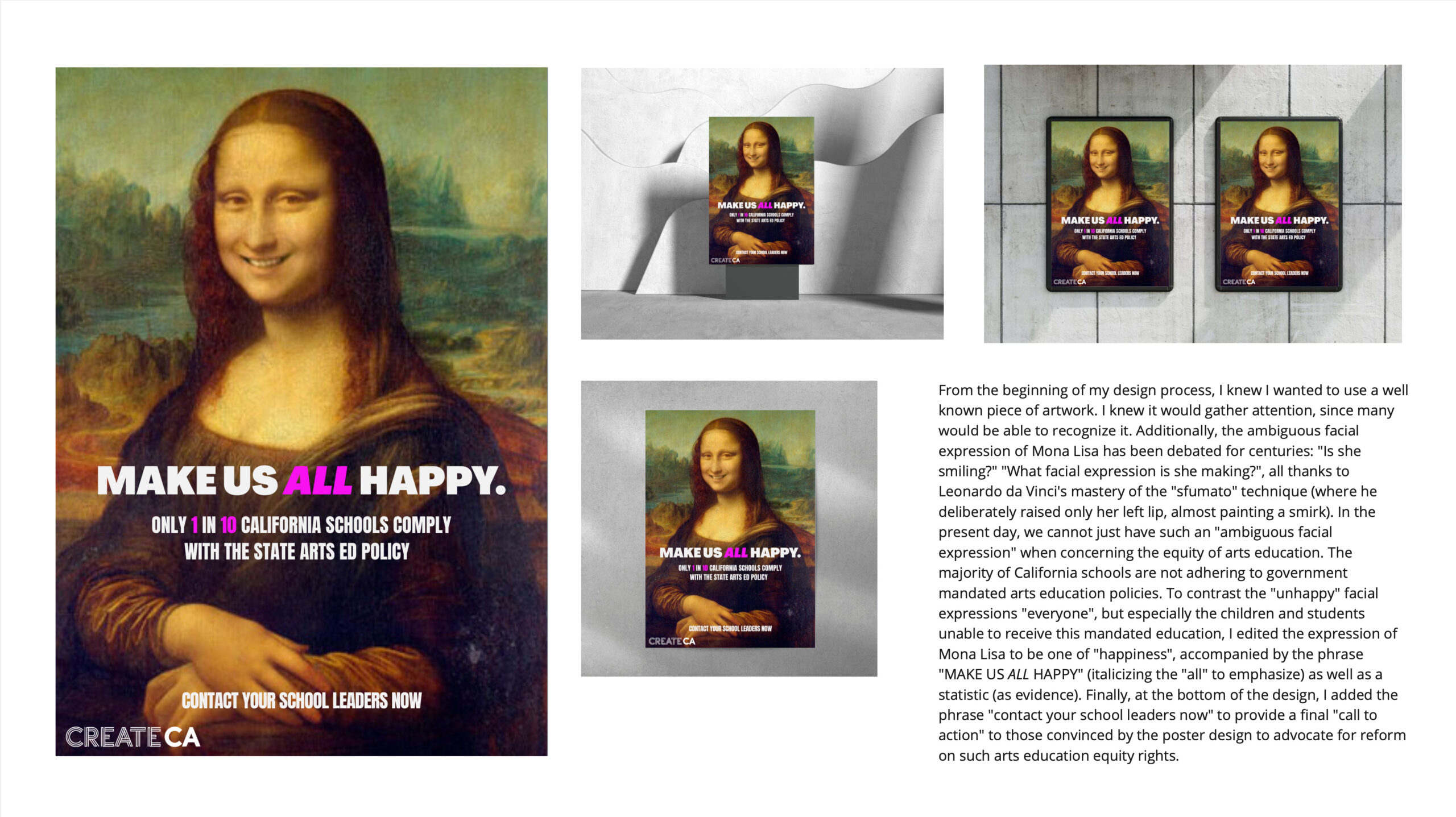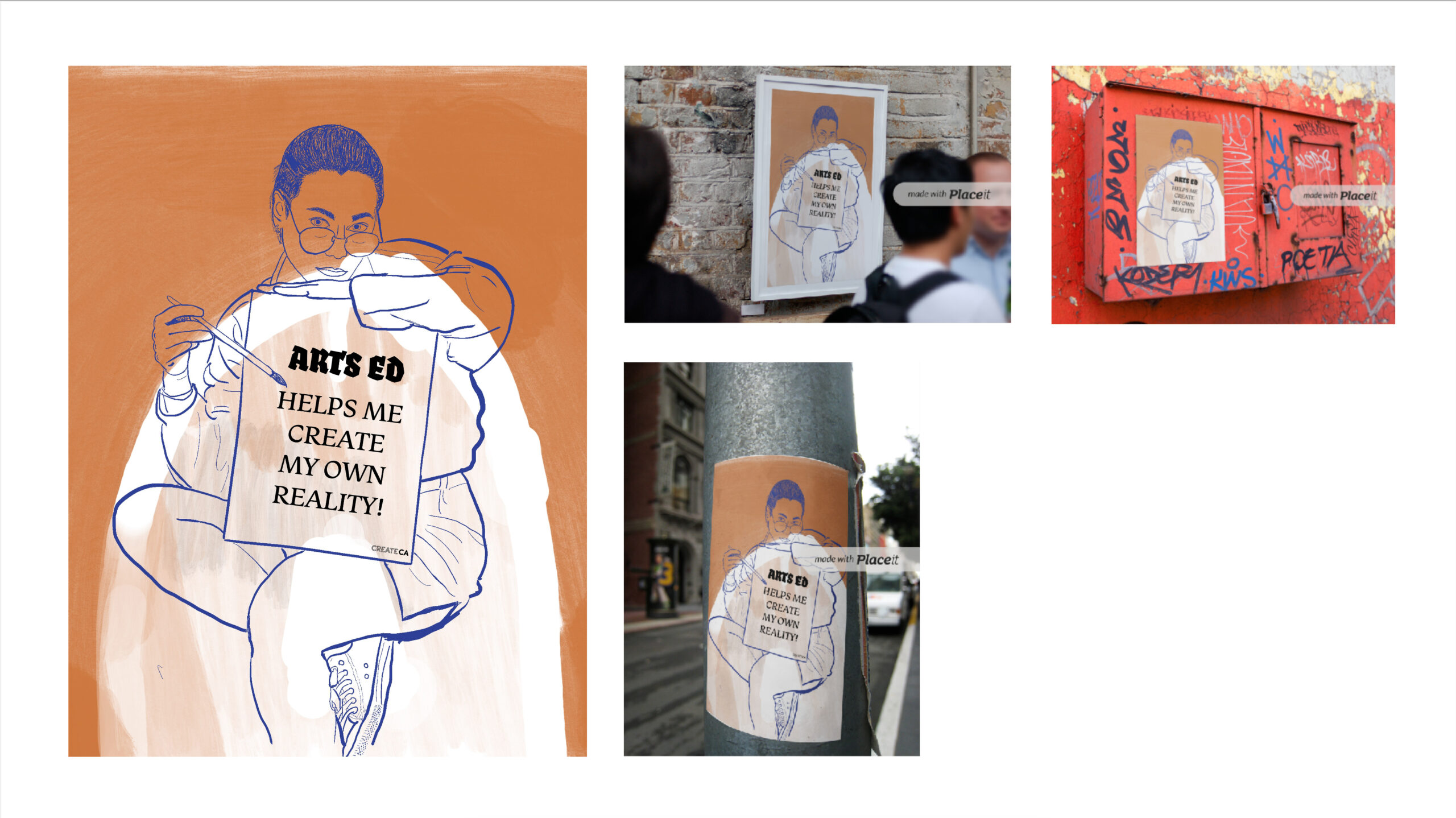Designing Advocacy: Arts Education + Graphic Design Implementation
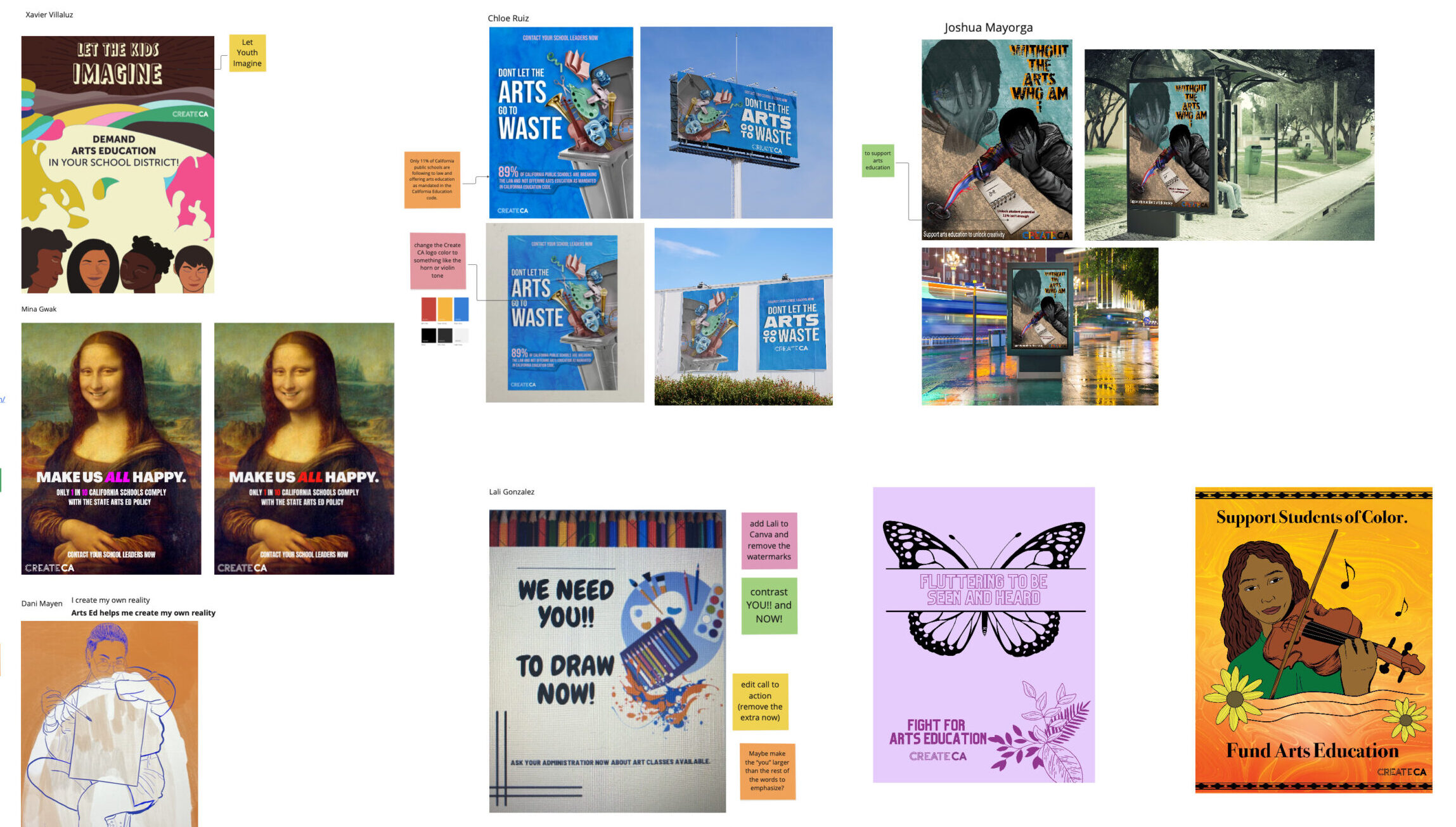
With support from the California Arts Council and in partnership with Create CA, a nonprofit that advocates for high-quality arts education for all students, this ArtCenter ACX studio invited high school and college students to learn organizing principles, case making and design process fundamentals as they translated concepts into powerful visual messaging. Meeting virtually, students from across California developed graphic posters that supported arts education, advocated for more arts options in California schools, and celebrated the benefits of studying the arts. Their final creations were showcased in a virtual gallery.
“Arts education is important for mental health, it’s important for well-being. It’s important that kids get art education because it helps them understand and advocate for themselves. Getting an education without arts education isn’t a complete thing. You’re not getting a full education.”
Leda Maliga, Cognito Agency
Project Brief
In the Spring of 2023, this ArtCenter ACX studio embarked on an empowering educational journey for high school and college students. The program aimed to equip students with a deep understanding of the design process and harnessing their creative abilities to champion arts education in public schools. Students from various regions of California united online to explore the principles of organization and persuasive argumentation. By synthisizing abstract concepts into visual messages, the students’ remarkable work not only celebrated the importance arts education but also advocated for an increased availability of artistic opportunities within the state’s public school system.
About Arts Education in California Schools
Arts education is essential for student well-being, academic success, preparation for 21st-century jobs and civic engagement – but California schools are falling behind in cultivating creativity.
A recent report, “Creativity Challenge: The State of Arts Education in California” conducted by SRI Education with funding from the William and Flora Hewlett Foundation, found that only 11% of California public schools meet the state’s education code to provide sequential standards-based arts education K-12 in music, dance, theater and visual arts. The report cites a lack of funding and a need for credentialed teachers; but the report also highlights successes, pointing to localized advocacy efforts from organizations like Create CA.

“A lot of my friends, colleagues and fellow designers don’t know about the issue of arts education in the public schools. If I made a design for them to really grasp what I’ve been through, and what we need to change, that would be a successful design to me.”
Chloe Ruiz, student
About California Arts Council and Create CA
Established by the State of California in 1976, the California Arts Council (CAC) is a state agency with a mission of strengthening arts, culture and creative expression as the tools to cultivate a better California for all. CAC is California’s only public arts grants provider with funding that is accessible to all 58 counties. As a state agency, CAC supports local arts infrastructure and programming statewide through grants, programs and services. Create CA advocates for high-quality arts education for all students by providing policy expertise and mobilizing a statewide network of advocates and allied partners.
Research and Project Development
The kick-off session welcomed students from across the state of California – who met virtually – to learn more about the design process and explore their own creativity. Arts and creativity, they were told, changes culture and helps society move forward. Each student shared what type of art inspires them the most. “Art is the only thing that gets me though the day,” one student shared.
A presentation described how the state of California education code mandated arts education – visual arts, dance, music, theater – in middle and high schools, but very few schools offer these classes. The challenge of this ACX studio would be to design a compelling visual that would address this inadequacy while celebrating the benefits of studying arts in the bigger lens. The issue of non-existent art programs in public schools reflects a racial and economic inequality; wealthier students typically join an afterschool arts program while those in rural or from low-income communities often do without.
Students examined the barriers that prevent schools from offering arts instruction: no suitable spaces, lack of supplies, and [lack of] credentialed teachers. Students discussed the barriers they personally have experienced or seen at their own schools. By contrast, studies describe how incorporating art into a young person’s education dramatically improves academic success and later in their professional career. Studying the arts is a method of self-discovery, understanding, and managing emotions. Student enthusiastically agreed, describing the fun and joy of art that helps them see the world in new ways.
Instructors showed how arts and culture, through carefully crafted campaigns, were instrumental in changing public opinion for the AIDS epidemic, marriage equality and cigarette smoking. Students examined the campaigns and began to see the thread of commonality. They were given questions that need to be addressed before any design is put on paper. Define: goals, a call to action, audience, best ways to reach that audience and what a success campaign would look like.

“I want students to know that on bad days we can simply grab a piece of paper and allow the pencil, pen, markers, etc. to do their thing. We can control what we want to create. What we feel will be represented in our art. it is important to have arts education in schools because it’s a way for students to express themselves.”
Riana Salazer, artist statement
For their first assignment, students described a social justice/advocacy campaign that influenced them – which set the stage for the rest of the studio. Their comments reflected their careful observations: “It was bold for the artist to create a design like this,” “A lot of these types of campaigns hit home for me,” “These slogans are easy to digest,” “The placement of the fonts really draw you in.”
Throughout the studio, students engaged in homework, in-class explorations and brainstorming sessions that would inspire their creativity and help them discover and refine their messaging concepts. Students were reminded about the goals of Create CA and their desire for a campaign to ‘spark a movement for arts education’ by raising awareness, educating the public and taking action – which could be a posting on social media, displaying a poster, writing to the editor, etc.
Classroom discussion involved how designers mine personal experiences into their creations. Students reflected on why art education matters to them. What is your “why” for this project? Where and how can you interject emotion into your concept? The message has to mean something; the more personalized the message, the more it can move hearts and minds, especially if the design captivates the viewer.
Students learned popular software applications, Procreate and Illustrator, to design their campaign poster. Instructors demonstrated how fonts, composition and color can support the thematic umbrella of messaging. Students critiqued examples on how information was presented – what worked? What didn’t? Other sessions offered a deep dive into font selection, coloring and other design elements.
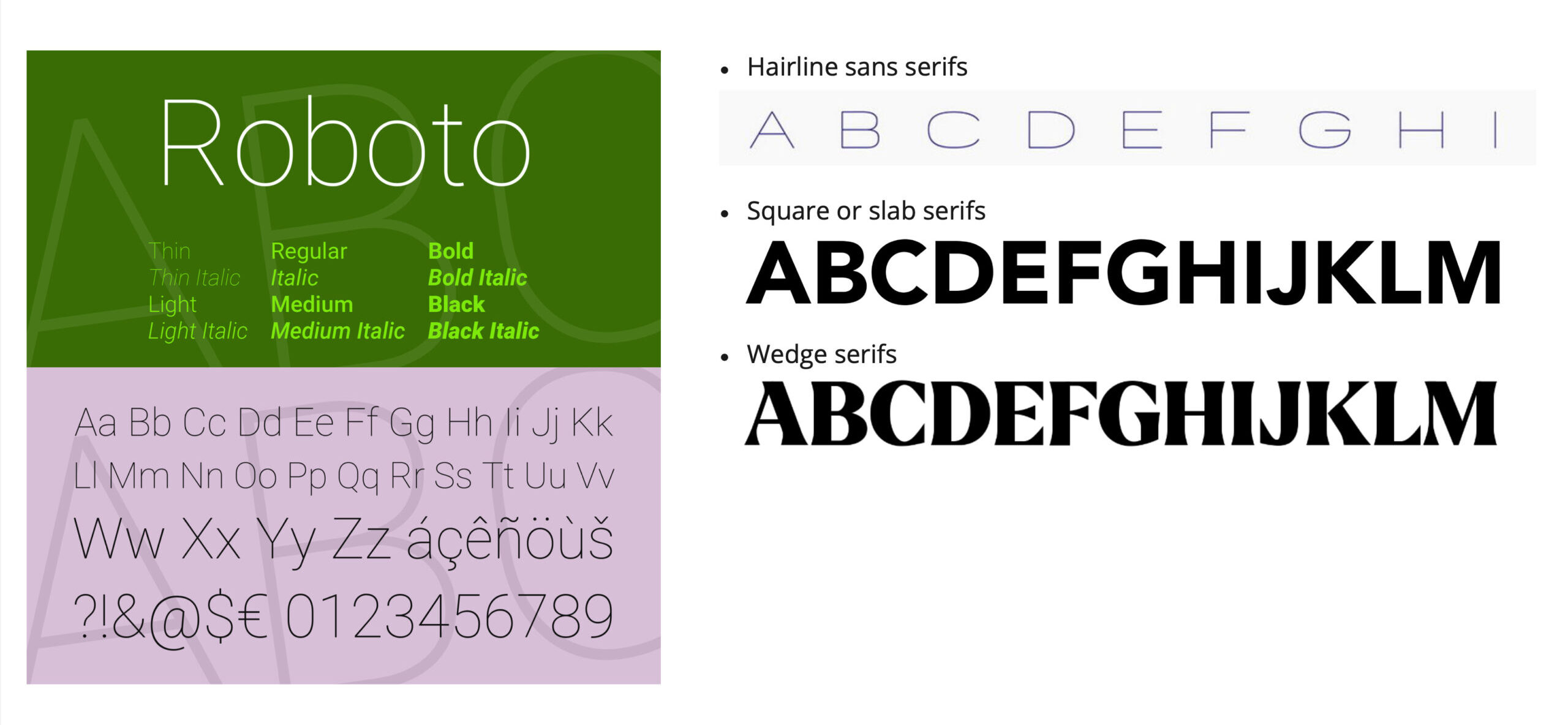
“Design that communicates intention, that’s how you want to direct people to behave. You want them to show up. You want them to do something. Call the mayor, send an email or something specific. You’re pushing people to mobilize and when you do that right as an artist, when you do it consistently, repeatedly, you can create culture shifts.”
Joel Garcia, Faculty
Social Justice, Ethnic Considerations
Students examined the principles of social-justice campaigns from the Design Justice Network which led to a discussion about unfair representations of ethnic communities in design/media. Instructors challenged the students: How can your design break out of that? How can you uplift and amplify those voices?
As they defined their vision and audience, students supported one another, realizing that some of their fellow students may need extra reassurance during sharing and class discussions. Many students often expressed how grateful they had this chance to explore art and their relationship to it. Instructors helped the students examine their own design ecosystems, the organizations and individuals who support them in their art journey and career planning.
“Our participants joined from all over the state with a wide range of lived experiences, and it was wonderful to hear directly from them. The students created a community of sharing, trust, and support, which was particularly impressive since it was done over Zoom. It was incredibly impressive to watch students, some of whom had never worked in digital art, build and develop their concepts over the weeks, creating impactful, message-based designs.”
Caitlin Lainoff, Youth Engagement Manager Create CA
At midterm, students shared their initial design thinking, describing the process that got them to this point. Members of Create CA and ArtCenter faculty/staff commented on the words, text and overall design, pointing out how simplicity works best and noting possible visual tools that could add to their concepts. Students appreciated the reassuring feedback; some had never experienced a formal critique. Partners and guests were inspired by all the ideas represented.
Students then refined their concepts. Students also created mockups of how their posters would look as billboards, bus benches, stickers, digital imagery on cell phones. Before making a final presentation, students composed an artist’s statement which described their concept and personal connection to arts education.
Outcomes
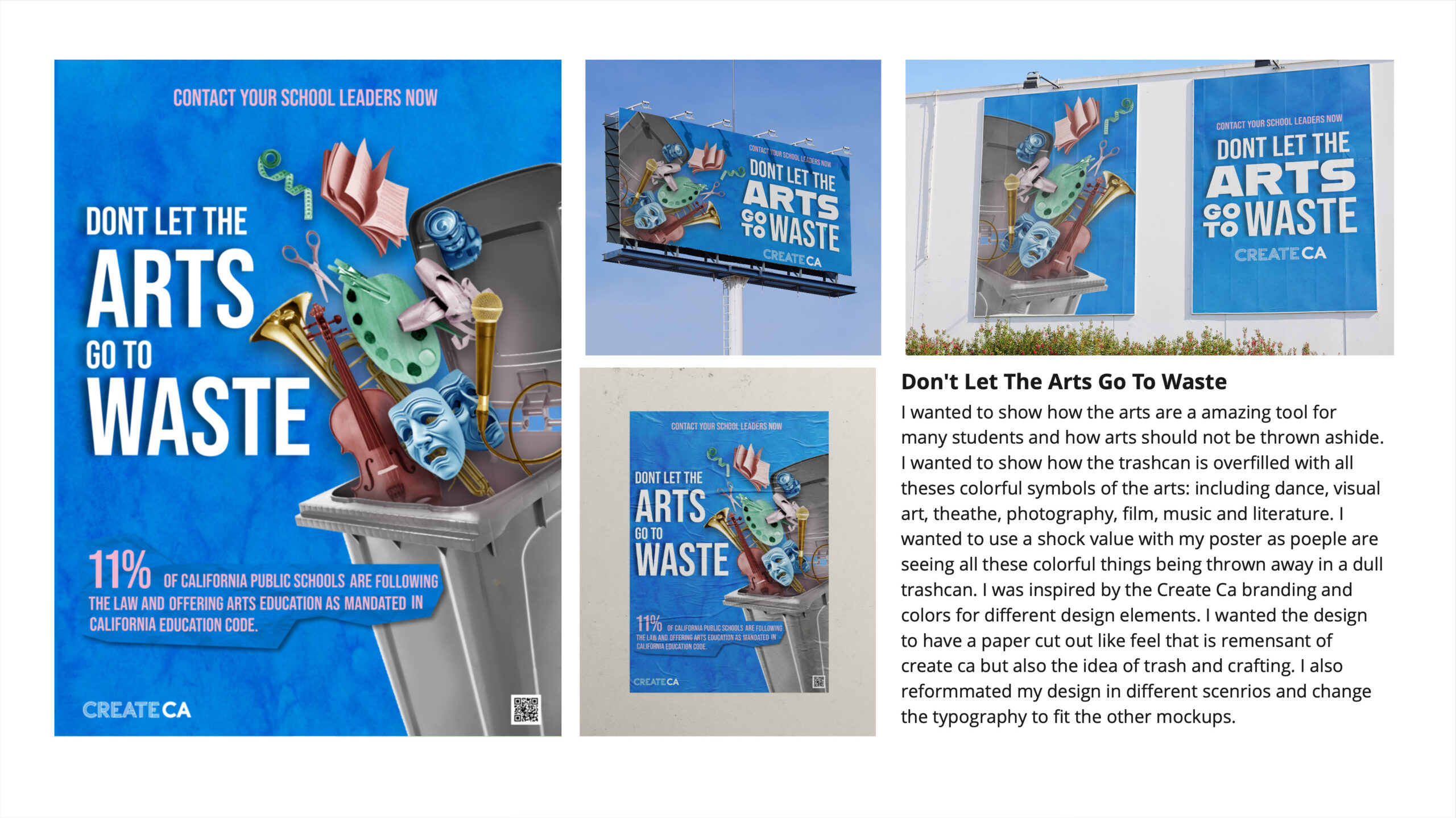 close
close
Dont Let Arts Go To Waste
Read moreChloe Ruiz
A gray open trash can is featured with a blue background. Colorful symbols of various art fields: ballet shoes, book, camera, microphone, drama/comedy masks, etc., are descending into the trash can. The headline text and the statistic text plead for schools to not dismiss – or throw away – arts education.
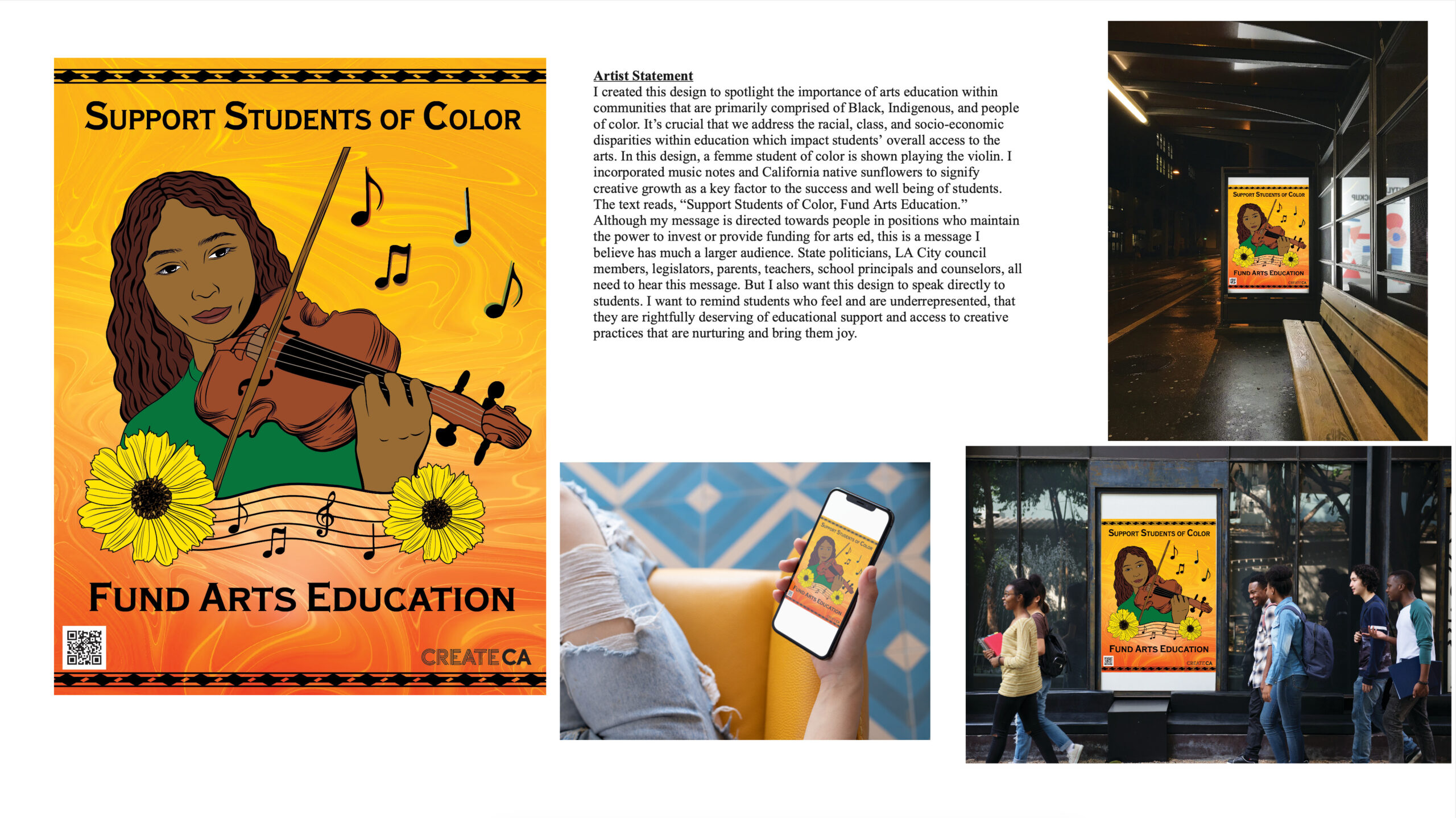 close
close
Support Students of Color
Read moreAriana Perez
An engaging image of a student of color playing the violin, an instrument often associated with white privilege. Cheery sunflowers and musical notes surround the musician who is shown against a swirling orange backdrop. Decorative accents that grace the top and bottom of the poster is reminiscent of designs used by indigenous people.
 close
close
Without The Arts Who Am I
Read moreJoshua Mayorga
A drawing of a young person with a stretched hand over his anguished face. Nearby, at a tabletop, the young person is slumped over his drawing pad but a stream of colors lifts off the page. Illustrating the internal struggle that many youth have, the concept offers hope to students through the power of art.
 close
close
Fluttering To Be Seen and Heard
Read moreRiana Salazar
A black and white line drawing of a butterfly stands out against a lilac purple backdrop. Darker maroon letters announce the message, positioned right on top of the butterfly. The bottom corner has decorative dark purple line drawings of plants, leaves and natural elements. The color is calm, but striking; butterflies are a symbol of transformation and flight – and easily identifiable by children and adults.
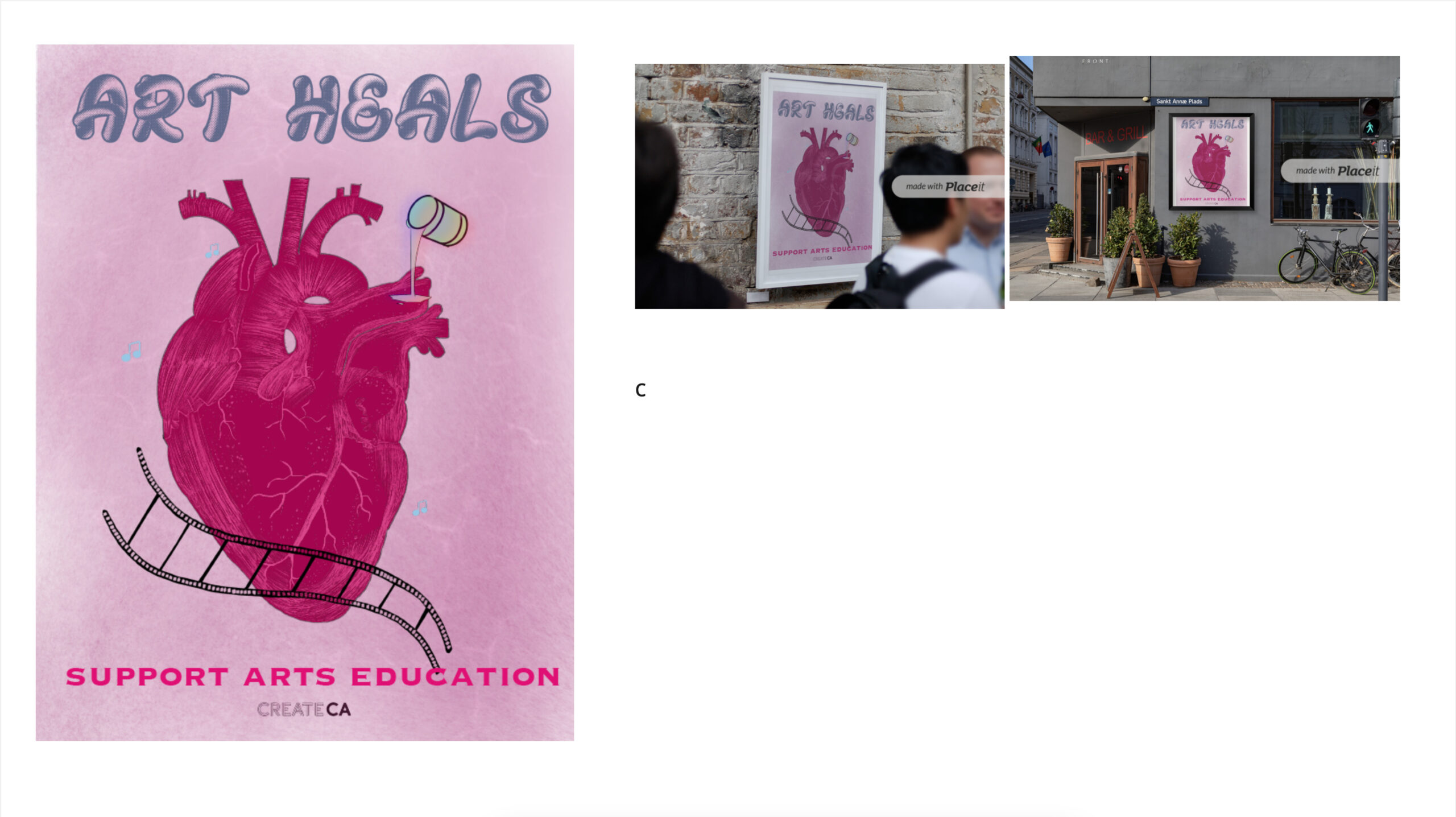 close
close
Art Heals
Read moreAlexandria Ybarra
This poster presents a human heart that is red and alive. Valves and blood vessels are shown. A paint can pours its colors onto the giant heart, while a twisty musical stanza weaves across the heart. The curvy and soft type for the heading feels organic and comforting.
 close
close
We Need You
Read moreXitlali Gonzalez
Resembling a case of colorful pencils, this poster encourages viewers to draw and express themselves. Other visual arts including palettes, oils, etc. are featured. A QR code can be scanned to learn about nearby art classes. Rainbow colors are a touchstone for LGBTQ+ youth.

